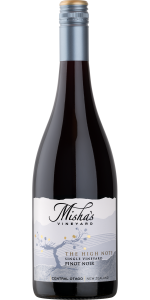
Description
"Dark ruby red, this Pinot Noir has a complex nose of wild thyme, rose-hip, red fruits and white spice and a beautiful palate that blends sweet fruit with a mineral purity." Olly Masters (Winemaker)
Awards
95 pts Wine Orbit
5 stars Michael Cooper’s Buyer’s Guide
91 pts Vinous by Antonio Galloni
94 pts The Real Review
Certifications
Alcohol
14.0%
Analytical data
dry
Vineyard
Misha's Vineyard - a 57-hectare single-vineyard estate of which 26 hectares are planted in Pinot Noir and aromatic whites. The vineyard is located in the Bendigo sub-region of Central Otago. Our first priority with the vineyard is careful stewardship of this spectacular land by managing our natural resources with respect. The vineyard is farmed according to the strict regime of sustainable farming practices and we ensure that vine health is never ever compromised. Our sun drenched north-west facing terraces give us one of the warmest sites in the region with the slopes and gullies providing excellent cool air drainage minimizing any risk of frost. Stretching from 210 to 350 metres above sea level, the plantings are predominantly on three levels of gently sloping terraces with just one steep face (the ‘ski slope’) where the rows run dramatically down to the lowest terrace poised just above Lake Dunstan.
The diversity in the soils, various levels and various meso-climates, different row orientations, as well as the range of clones planted, enable complexity in the wines that few single vineyards can match. Our land is also located within a zoned protection area due to the ‘outstanding landscape’ features including schist outcrops, steep escarpments, and gullies filled with native manuka and wild grasses.
Topography: Moderate to steep slopes, gently undulating fans and remnant terraces comprising wind-eroded and water dissected minor ridges and associated areas of loess accumulations. Soils range from outcrops of schist to very fine dusty sands; from extremely hard red boulders to pockets of sticky red clay; and from river gravels to coarse sands - even a small pocket of rich loam. These soils are very complex as they are essentially a combination of glacial outwash and river gravels but generally fit under the classification of Clyde sandy loam.
Vinification
The fruit was chilled overnight before crushing the next day typically as 1.5 and 4 tonne lots. The crushed fruit was then cold soaked for 5-7 days after then allowed to warm as the natural yeast ferment took place. An average of 6% whole bunch component was included. Cooling was used to ensure the ferments peaked below 32⁰C. The wine was then held warm (15-20⁰C) post ferment to allow ongoing tannin integration. After an average of 27 days on skins the wines were then pressed to tank where they were settled for 1–2 days before being racked into French oak hogsheads (25% new 300 litre barrels). The wine was inoculated for malolactic fermentation which took place in the following spring, then racked out of barrels and filtered prior to bottling in Feb 2020.
Maturation
The fruit was chilled overnight before crushing the next day typically as 1.5 and 4 tonne lots. The crushed fruit was then cold soaked for 5-7 days after then allowed to warm as the natural yeast ferment took place. An average of 12% whole bunch component was included. Cooling was used to ensure the ferments peaked below 32⁰C. The wine was then held warm (15-20⁰C) post ferment to allow ongoing tannin integration. After an average of 26 days on skins the wines were then pressed to tank where they were settled for 1–2 days before being racked into French oak hogsheads (18% new 300 litre barrels). The wine was inoculated for malolactic fermentation which took place in the following spring, then racked out of barrels and filtered prior to bottling in Feb 2022.


